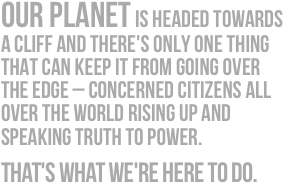by Trudi Zundel
With food security threatened throughout the developing world, the global community has been paying a lot more attention to the effect of climate change on agriculture. More volatile weather patterns makes planning crop rotations difficult; higher concentration of rain patterns, whether dry or wet spells, means that fields either dry out or wash away–and farmers have little indication of which pattern will come when. The 2°C warming that Parties agreed to in Cancun is predicted by the IPCC to result in a 4-5 degree warming across Africa, which would pose an unimaginable threat to agriculture in the region. Needless to say small-shareholder farmers, who constitute the majority of farmers worldwide, are in desperate need of resources to help them adapt to their new conditions.
One way of the best ways of adapting is to increase the resilience of the farming ecosystem–agroecology (or sustainable agriculture in general, but that definition can be interpreted in many ways) is a way of farming that is modelled after a natural ecosystem: incorporating biodiversity, compost, mulches, perhaps a bit of agroforestry.
One thing that’s important to know about soils is that they can take carbon out of the air. I’m not a soil scientist, but I trust that this is true. The “richer” or “healthier” a soil is, the more carbon it can fix, or sequester. Sustainable agricultural practices improve the soil sequestration rate—how much carbon soils are able to take out of the air. In an ideal world, this wouldn’t be a problem: farmers would have more resilient land, and more carbon would happen to be removed from the atmosphere. However, here in the sad reality of the UNFCCC, where profits take priority over people and the market reigns supreme, soil sequestration could be the death of a meaningful adaptation programme for agriculture. Policy-makers who are looking for new ways to mitigate climate change have latched onto this fact, and want to use soil carbon sequestration to create a new carbon offset market.
The World Bank has been subversively spearheading the idea of climate-smart agriculture— sustainable agriculture that is a triple-win: farmers increase food security, adapt to climate change, and carbon is mitigated. The Bank also happens to be one of the organizations most likely to profit from soil carbon markets. It is not interested in an agricultural work programme that would benefit the poor, but instead in the profits it thinks it can make from a market (after all, it is a bank first).
Many policy-makers are saying that climate-smart agriculture is the ideal intersection of adaptation and mitigation. The problem is that mitigation for offsets must be quantified. That means measuring, reporting, and verifying the amount of carbon stored in the soil–which leads to technocratic experts coming onto small-shareholders’ farms to tell them what practices will maximize soil sequestration. While land may end up being more resilient under these projects, it will most likely just be a co-benefit—despite claims from the World Bank and FAO of the opposite. farmers’ sovereignty over their own land will naturally be compromised if they don’t have complete control over their own practices. What’s worse, they’ll be dictated practices that maximize mitigation; there’s no money to be made off of adaptation for adaptation’s sake.
Where’s agriculture in the text?
We’re at a dangerous point now: for a few years Parties have been trying to push an agricultural work programme under Article 1. b. iv of the Bali Action Plan, which is “sectoral approaches to enhance mitigation.” If agriculture is under mitigation, there really is nothing guaranteeing funding for agricultural adaptation. There has been some talk in Durban about an agricultural work programme somewhere in adaptation… this is also not to be trusted. Given the rampant expansionism of carbon markets under REDD+, any inclusion of agriculture could be twisted to legitimize soil carbon markets.
Food and agricultural organizations are very excited about climate-smart agriculture; it actually seems to be becoming a buzz-word, appearing in several publications from different organizations. The side events about climate-smart appear to be focussed on justifying the need for sustainable agriculture in the first place: statistics, charts, and graphs about how innovation increases food security. I always forget that the world is far behind—the inherent value of sustainable agriculture isn’t assumed. Organizations in support of climate-smart agriculture are too focused on justifying the benefits of sustainable agriculture, and don’t understand the subtler threats of its place under mitigation (or don’t care).
It seems likely that agriculture will make it into the text somewhere in a Durban outcome, especially if a text is presented at the end like in Cancun. Zuma has publicly said that he wants a work programme for agriculture; the World Bank has been attended African agricultural ministerials all year to try and get them on board. In general, civil society seems wary of the work programme and its not-so-subtle connection to carbon markets.
Like I said in my last blog, developing countries have to be really, really wary of false solutions here in Durban. Countries are feeling pressure for a successful outcome, but aren’t willing to make any concessions—instead, they’re using their resources and creativity to assemble solutions that make them look good. An agricultural work programme looks good, especially given that this is an African COP, but it is a wolf very cleverly disguised in sheep’s clothing.



Climate Smart Agriculture is not intended to make food production and development sustainable. It is designed to make poverty & hunger sustainable
Read: http://devconsultancygroup.blogspot.com/2011/11/oxfams-and-actionaids-climate-smart.html